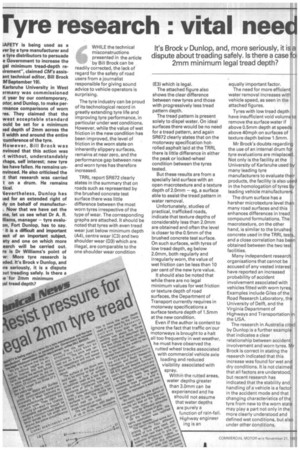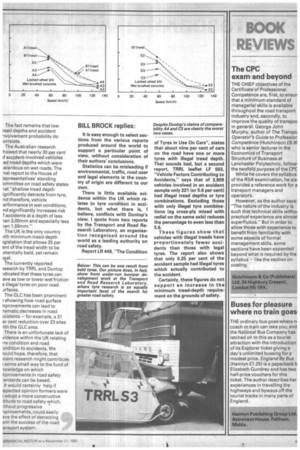Tyre research : vital need
Page 40

Page 41

If you've noticed an error in this article please click here to report it so we can fix it.
It's Brock v Dunlop, and, more seriously, it is a dispute about treading safely. Is there a case foi 2mm minimum legal tread depth?
iAFETY is being used as a ver by a tyre manufacturer and e tyre distributors to persuade e Government to increase the gal minimum tread-depth repirement", claimed CM'S assisant technical editor, Bill Brock 'MSeptember 19).
Karlsruhe University in West rmany was commissioned A year by our contemporary, (tor, and Dunlop, to make perrmance comparisons of worn res. They claimed that the west acceptable standard ould. be set for a minimum lad depth of 2mm across the II width and around the entire .cumference of the tyre.
However, Bill Brock was nvinced that this action was it without, understandably rhaps, self interest; new tyre les have fallen. He remains unnvinced. He also criticised the :t that research was carried t on a drum. He remains tical.
levertheless, Dunlop has ced for an extended right of ply on behalf of manufactur. Now that we have set the me, let us see what Dr A. R. !hams, manager — tyre evaluon, Fort Dunlop, has to say. it is a difficult and important me of an important subject, ety and one on which more earch will be carried out. re is Dr Williams's point of w: More tyre research is .tded. It's Brock v Dunlop, and ire seriously, it is a dispute )ut treading safely. Is there a ie for 2mm minimum pal tread depth? WHILE the technical misconstructions presented in the article by Bill Brock can be readily corrected, the lack of regard for the safety of road users from a journalist responsible for giving sound advice to vehicle operators is surprising.
The tyre industry can be proud of its technological record in greatly extending tyre life and improving tyre performance, in particular under wet conditions. However, while the value of wet friction in the new condition has been improved, the level of friction in the worn state on inherently slippery surfaces, remains at near zero, and the performance gap between new and worn tyres has therefore increased.
TRRL report SR672 clearly states in the summary that on roads such as represented by the brushed concrete test surface there was little difference between the most worn tyres irrespective of the type of wear. The corresponding graphs are attached. It should be noted that tyres with even tread wear just below minimum depth (A4), centre wear (C3) and two shoulder wear (03) which are illegal, are comparable to the one shoulder wear condition (E3) which is legal.
The attached figure also shows the clear difference between new tyres and those with progressively less tread pattern depth.
The tread pattern is present solely to dispel water. On ideal surfaces there would be no need for a tread pattern, and again SR672 clearly states that on the motorway specification hotrolled asphalt laid at the TRRL there is little difference in either the peak or locked-wheel condition between the tyres tested.
But these results are from a specially laid surface with an open macrotexture and a texture depth of 2.0mm — eg, a surface able to assist the tread pattern in water removal.
Unfortunately, studies of practical, trafficked roads, indicate that texture depths of considerably less than 2.0mm are obtained and often the level is closer to the 0.5mm of the brushed concrete test surface. On such surfaces, with tyres of low tread depth, eg below 2.0mm, both regularly and irregularly worn, the value of wet friction can be less than 10 per cent of the new tyre value.
It should also be noted that while there are no legal minimum values for wet friction or texture depth of road surfaces, the Department of Transport currently requires in motorway specifications a surface texture depth of 1.5mm at the new condition.
Even if the author is content to ignore the fact that traffic on our motorways is brought to a halt all too frequently in wet weather, he must have observed the rutted wheel tracks associated with commercial vehicle axle loading and reduced visibility associated with spray. _ Within the rutted areas, water depths greater than 3.0mm can be experienced and he should not assume that Water depths are purely a
function of rairifall. Highway engineer ing is an
equally important factor.
The need for more efficient water removal increases with vehicle speed, as seen in the attached figures.
Tyres with low tread depth have insufficient void volume to remove the surface water if above 0.5mm depth at speeds above 40mph on surfaces of texture depth below 1.5mm.
Mr Brock's doubts regarding the use of an internal drum for tyre evaluations are misplaced. Not only is the facility at the University of Karlsruhe used by many leading tyre manufacturers to evaluate their products, the facility is also used in the homologation of tyres by leading vehicle manufacturers. The drum surface has a harsher microtexture level than many road surfaces and this enhances differences in tread compound formulations. The macrotexture, on the other hand, is similar to the brushed concrete used in the TRRL tests, and a close correlation has been obtained between the two test facilities.
Many independent research organisations that cannot be accused of any vested interest have reported an increased probability of accident involvement associated with vehicles fitted with worn tyres. Examples include Giles of the Road Research Laboratory, the University of Delft, and the Virginia Department of Highways and Transportation in the USA.
The research in Australia cited by Dunlop is a further example that indicates a clear relationship between accident involvement and worn tyres. Mr Brock is correct in stating the research indicated that this increase was found for wet and dry conditions. It is not claimed that all factors are understood, but recent research has indicated that the stability and handling of a vehicle is a factor in the accident mode and that changing characteristics of the tyre from new to the worn state may play a part not only in the more clearly understood and defined wet conditions, but also under other conditions. The fact remains that low read depths and accident lvolvement probability do orrelate.
The Australian research howed that nearly 30 per cent if accident-involved vehicles ad tread depths which were azardous on wet roads. The nal report to the House of lepresentatives' standing ommittee on road safety states lat "shallow tread depth ignificantly detracts from tyre, nd therefore, vehicle erformance in wet conditions, nd significantly increases risk f accidents at a depth of less Ian 3.00mm and especially less -Ian 1.55mm."
The UK is the only country tith minimum tread-depth gislation that allows 25 per ent of the tread width to be otentially bald, yet remain
The currently reported ?search by TRRL and Dunlop idicated that these tyres can ave as low or lower wet-friction s illegal tyres on poor road Jrfaces.
The GLC has been prominent showing how road surface nprovements can lead to ramatic decreases in road ccidents — for example, a 31 er cent reduction over 23 sites gith the GLC area.
There is an unfortunate lack of vidence within the UK relating (re condition and road pridition to accidents. We gould hope, therefore, that ;cent research might contribute some small way to the fund of lowledge on which nprovements in road safety Andards can be based. It would certainly help if !spected opinion formers were
adopt a more constructive :titude to road safety which, ithout progressive iprovements, could easily 3ve the effect of detracting em the success of the road ansport system.
BILL BROCK replies:
It is easy enough to select sections from the various reports produced around the world to support a particular point of view, without consideration of their authors' conclusions.
Statistics can be misleading if environmental, traffic, road user and legal elements in the country of origin are different to our own.
There is little available evidence within the UK which relates to tyre condition in accidents, but what there is, I believe, conflicts with Dunlop's view. I quote from two reports by the Transport and Road Research Laboratory, an organisation recognised around the world as a leading authority on road safety.
Report LR 449, "The Condition of Tyres in Use On Cars", states that about nine per cent of cars on the road have one or more tyres with illegal tread depth. That sounds bad, but a second report, TRRL leaflet LF 593, "Vehicle Factors Contributing to Accidents," says that of 3,909 vehicles involved in an accident sample only 221 (or 5.6 per cent) had illegal tread depths or tyre combinations. Excluding those with only illegal tyre combinations leg cross-ply mixed with radial on the same axle) reduces the percentage to even less than 5.6.
These figures show that vehicles with illegal treads have proportionately fewer accidents than those with legal tyres. The report also shows that only 0.25 per cent of the accident sample had illegal tyres which actually contributed to the accident.
Certainly, these figures do not support an increase in the minimum tread-depth requirement on the grounds of safety.


















































